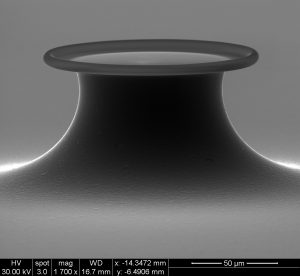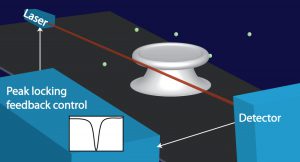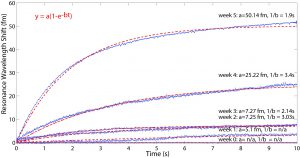Research
Detecting molecules at extremely low concentrations is essential for advancing basic science, developing earlier and more accurate medical diagnostics, and protecting the environment. Our lab develops optical sensing technologies to meet these challenges, with the goal of revealing signals invisible to conventional methods.
At the core of this effort is FLOWER (Frequency Locked Optical Whispering Evanescent Resonator), a sensing platform built on whispering gallery mode (WGM) resonators, most often implemented as microtoroids (Figure 1). FLOWER keeps the resonator synchronized with the laser. When a molecule binds, the resonator’s frequency changes, and the laser controller must adjust its voltage to keep up. By measuring these tiny voltage changes, FLOWER can detect single molecules with extraordinary sensitivity.
With this approach, FLOWER achieves label-free, ultra-sensitive detection at the single-molecule level — capable of identifying proteins as small as 15.4 kDa without the need for fluorescent or chemical labels. Crucially, FLOWER is not limited to purified solutions; it maintains high sensitivity in complex biological samples such as serum and urine, making it well suited for both biomedical diagnostics and real-world environmental monitoring.


Key references:
Suebka, S., Gin, A., Su, Judith, Frequency Locked Whispering Evanescent Resonator (FLOWER) for biochemical sensing applications, Nature Protocols (2025) https://doi.org/10.1038/s41596-024-01096-7 (selected by Nature Protocols as the journal’s Protocol of the Week)
Gin, A., Nguyen, P-D., Melzer, J., Li, C., Strzelinski, H., Liggett, S.B., Su, Judith, Label-free, real-time monitoring of membrane binding events at zeptomolar concentrations using frequency-locked optical microresonators, Nature Communications, 15, 7445 (2024).
Gin, A., Nguyen, P-D., Serrano, G., Alexander, G, Su, Judith, Towards Early Diagnosis and Screening of Alzheimer’s Disease Using Frequency Locked Whispering Gallery Mode Microtoroid Biosensors, npj Biosensing, 1, 9 (2024). (Editorially highlighted with a homepage hero image on the npj Biosensing website)
Su, Judith, Goldberg. A.F, Stoltz, B.M. “Label-free single detection of single nanoparticles and biological molecules using microtoroid optical resonators,” Light: Science and Applications, 5, e16001 (2016). (Winner of a best paper award from Light: Science & Applications )
Suebka, S., Nguyen, P-D, Gin, A, and Su, Judith, How fast it can stick: visualizing flow delivery to microtoroid biosensors, ACS Sensors, 7, 2700–2708, (2021), (supplementary cover)
Hao, S. and Su, Judith, Noise-induced limits of detection in frequency locked optical microcavities, Journal of Lightwave Technology, 38(22), 6393 – 6401 (2020).
United States Patent Numbers 9,737,770 and 10,309,960
Basic science
Our lab is interested in utilizing the high sensitivity and quick response time of our devices to study the basics of pain, olfaction, and taste.
Key references:
Yang, M-Y^, Mac, Khuong D.M^, Strzelinski, Hannah R., Hoffman, S.A., Kim, D., Kim, S-K, Su, Judith,* Liggett, S.B.*, III Goddard, W.A,* Agonist activation opening the Ga subunit of the GPCR–GProtein precoupled complex defines functional agonist activation of TAS2R5 GPCR, Proceedings of the National Academy of Sciences (PNAS), 121, e2409987121 (2024), ^co-first author, * co-corresponding author.
Hao, S., Guthrie, B., Kim, S-K, Kubicek, J., Murtaza, B., Khan, N.A., Khakbaz, P. , Su, Judith*, III Goddard, WA*, Steviol rebaudiosides bind to four different sites of the human sweet taste receptor (T1R2/T1R3) complex explaining confusing experiments, Communications Chemistry, 7, 236 (2024), co-corresponding author
Translational medicine
We have used FLOWER to successfully sense low concentrations of exosome (~ 40 nm nanovesicle) cancer biomarkers in mouse serum (Figure 2). In these experiments, female mice (n = 5) born on the same day were implanted with Daudi (human Burkitt’s lymphoma) tumor cells for 5 weeks. One microliter of serum from each mouse each week was diluted a million-fold in 0.9% saline and sequentially flowed over a microtoroid covalently functionalized with anti-CD81, an exosome-specific marker. A close inspection of a binding curve (Figure 4) shows discrete changes, or steps, in the resonance wavelength (λ) of the microtoroid as individual exosomes bind to the surface of the microtoroid.
Figure 2. Exosome binding curves. Mice were implanted with human Burkitt’s lymphoma tumor cells, and each week blood serum samples were taken and later analyzed all together using FLOWER. The curves shown here are from a single mouse. For each week we see an increase in the response from the sensor corresponding to increasing exosome levels. No significant signal was obtained from week 0. The data traces are fit with a simple exponential (dashed red line) corresponding to first-order kinetics.
Key references:
Hao, S., Su, Judith, Whispering gallery mode optical resonators for biological and chemical detection: current practices, future perspectives, and challenges, Reports on Progress in Physics, 88 016402, (2025).
Gin, A., Nguyen, P-D., Serrano, G., Alexander, G, Su, Judith, Towards Early Diagnosis and Screening of Alzheimer’s Disease Using Frequency Locked Whispering Gallery Mode Microtoroid Biosensors, npj Biosensing, 1, 9 (2024). (Editorially highlighted with a homepage hero image on the npj Biosensing website)
Kim, S-K, Suebka S., Gin A., Nguyen, P-D., Tang Y., Su, Judith*, III Goddard, WA*, Methotrexate inhibits the binding of the severe acute respiratory syndrome coronavirus 2 (SARS-CoV-2) receptor binding domain to the host cell angiotensin converting enzyme-2 (ACE-2) receptor, ACS Pharmacology & Translational Science, 7, 2, 348–362 (2024), *co-corresponding author (supplementary cover)
Luu, G., Ge., C., Tang, Y., Li, K., Cologna, S., Burdette, J., Su, Judith*, and Sanchez, L.*, An integrated approach to protein discovery and detection from complex biofluids, *co-corresponding author, Molecular & Cellular Proteomics, 2023
Dell’Olio, F., Su, Judith, Huser, T., Sottile, V., Alix-Panabières, C. Photonic technologies for liquid biopsies: recent advances and open research challenges, Laser & Photonics Reviews, 15, 2170012 (2021) (back cover).
Su, Judith, Label-free single exosome detection using frequency locked microtoroid optical resonators, ACS Photonics 2, 1241–1245 (2015).
Environmental monitoring
FLOWER has demonstrated part-per-trillion detection of toxic industrial chemicals and chemical warfare agent surrogates and precursors. This work is funded by the Defense Threat Reduction Agency (DTRA).
Key references:
Xu, Y, Stanko, A, Cerione, C, Lohrey, T, McLeod, E., Stoltz, B., Su, Judith, Low part-per-trillion, humidity resistant detection of nitric oxide using microtoroid optical resonators , ACS Applied Materials & Interfaces, 16, 4, 5120–5128 (2024)
Li, C., Lohrey, T.D., Nguyen, P-D., Min, Z., Tang, Y., Ge, C., Sercel, Z.P., McLeod, E., Stoltz, B.M., Su, Judith, Part-per-trillion trace selective gas detection using frequency locked whispering gallery mode microtoroids, ACS Applied Materials & Interfaces, 14, 37, 42430–42440 (2022) (supplementary cover).
Next generation sensing platforms
We work on building our next generation sensing platforms, this includes adding spectroscopic capabilities to our devices as well as working on ways to boost the sensitivity of our sensors.
Key references:
Hao, S, Suebka, S., Su, Judith, Single 5-nm quantum dot detection via microtoroid optical resonator photothermal microscopy Light: Science & Applications, 13, 195 (2024). (featured in Optics & Photonics News Year in Optics 2025 which highlights the the most exciting optics research to emerge in the preceding 12 months)
Choi, G. and Su, Judith, Impact of stimulated Raman scattering on dark soliton generation in a silica microresonator, J. Phys. Photonics, 5, 014001 (2023) (special issue on Emerging Leaders 2023).
Choi, G., Gin., A., and Su, Judith, Optical frequency combs in aqueous and air environments at visible to near-IR wavelengths, Optics Express, 30, 8690-8699 (2022)
Li, C., Chen, L., McLeod, E., Su, Judith, “Dark mode plasmonic optical microcavity biochemical sensor,” Photonics Research, 7(8), 939-947(2019).
Nguyen, P-D., Zhang, X., Su, Judith, One-step controlled synthesis of size-tunable toroidal gold particles for biochemical sensing, ACS Applied Nano Materials, 2(12), 7839-7847 (2019).
Portable, point-of-care, ultra-sensitive biosensors
In collaboration with the McLeod Laboratory, we are working to miniaturize these sensors, making them easily translatable to other labs and clinics.
Key references:
Suebka, S, McLeod, E., Su, Judith, Ultra-high-Q free space coupling to microtoroid resonators, Light: Science & Applications, 13, 75 (2024) (Most downloaded paper, May 2024)
Chen, L., Li, C., Liu, Y., Su, Judith*, McLeod, E.* “Simulating robust far-field coupling to traveling waves in large three-dimensional nanostructured high-Q microresonators,” Photonics Research, 7 (9), 967-976 (2019), *co-corresponding author

